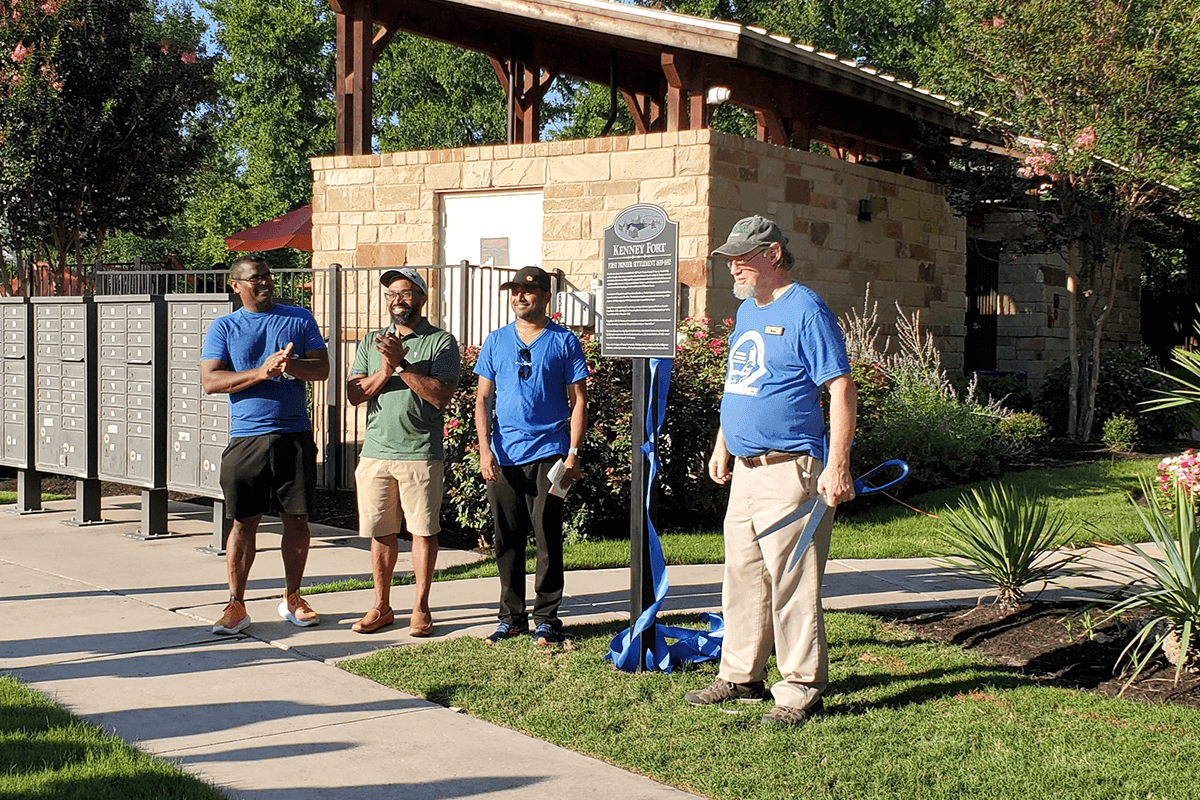New historical marker for Kenney Fort site dedicated

On June 6, Round Rock Preservation and the Concord at Brushy Creek Homeowners Association held a ribbon-cutting to dedicate a new historical marker for the site of Kenney Fort, which is listed in the National Register of Historic Places. Kenney Fort, a Republic of Texas-era fort, was the first pioneer settlement in what later became Williamson County but was abandoned in the 1850s and had all but disappeared by the 1930s. This new marker stands close to the fort’s original location, next to what is now the homeowners association swimming pool at 2351 Centennial Loop.
The marker and installation was funded by Round Rock Preservation, a nonprofit that advocates for the preservation of the city’s historic buildings and hosts educational events about local history. Round Rock Preservation Vice-President Frank Darr worked with local author Elroy Haverlah to create the marker text, and with Antonio Santana of the homeowners association to select the location. At the ribbon-cutting, Round Rock Preservation President Judy Anderson gave an overview of the marker project, and Vice-President Frank Darr outlined the significance of Kenney Fort.
There is also an existing state marker for Kenney Fort on Palm Valley Blvd. which was erected for the Texas Centennial in 1936. By this time the fort was gone and the site had been converted to farmland. The marker was placed on Palm Valley Blvd. because at ½ mile away it was the closest public road. The older marker will remain where it is; however, the new marker is much closer to the actual site of the fort and includes more information about it.
About Kenney Fort
Kenney Fort was built in 1839 by Dr. Thomas Kenney and Joseph Barnhart, and was used as a shelter and refuge by the first settlers claiming headrights in the area. The fort was the site of two significant events in the history of the Republic of Texas. It was the starting point for the 1841 Santa Fe Expedition, undertaken in an attempt to convince the leaders of Santa Fe to secede from Mexico and join Texas, which ended in dismal failure. In 1842 as part of an attempt to move the Capitol from Austin to Houston the land records were smuggled out of Austin, pursued by angry residents armed with a cannon. The thieves got as far as Kenney Fort, where their surrender was negotiated and the land record archives returned to Austin. For more information refer to the Planning and Development Services Department’s pages on Kenney Fort, the Santa Fe Expedition, and the Archives War.
Marker text
KENNEY FORT
First Pioneer Settlement 1839 – 1852
Near this site, Kenney Fort was established in 1839 by Dr. Thomas Kenney. Dr. Kenney, his wife Polly, and their daughter Mary Jane, were early settlers from Steven F. Austin’s colony. Dr. Kenney, a veteran of the Battle of San Jacinto (1836), built this stockade fort next to the Double File Trail which was a trail originally used by the area’s Indigenous inhabitants. This fort was the first pioneer settlement in this area and marked the beginnings of what would become Williamson County.
Constructed with log cabins made from elm and hackberry, the fort’s layout included a stockade fence. It provided shelter to up to 15 settlers. The shaded courtyard was a communal area serving multiple purposes, including engaging with Indigenous peoples in peaceful exchanges.
Kenney Fort was pivotal in early Texas history, serving as the starting point of the Texan Santa Fe Expedition in 1841, under Republic of Texas President Mirabeau B. Lamar. It also played a part in the Texas Archives War in December 1842.
Tragically, in 1844, Dr. Kenney and two companions were lost in a conflict with Native Americans near Salado, where they were buried. This spot is known today as “Bone Hollow.”
Mary Jane (Kenney) Lee, a key figure in the fort's history, described its location along Brushy Creek, highlighting the importance of natural landmarks in the area. She lived at the fort until 1852, when it was sold to Swedish immigrant S. M. Swenson.
Today, only the legacy of Kenney Fort remains. The history here is a tapestry of settler, Indigenous inhabitants, and immigrant stories, reflecting the complex heritage of Williamson County and Texas.
The post New historical marker for Kenney Fort site dedicated appeared first on City of Round Rock.
Source: City of Round Rock





